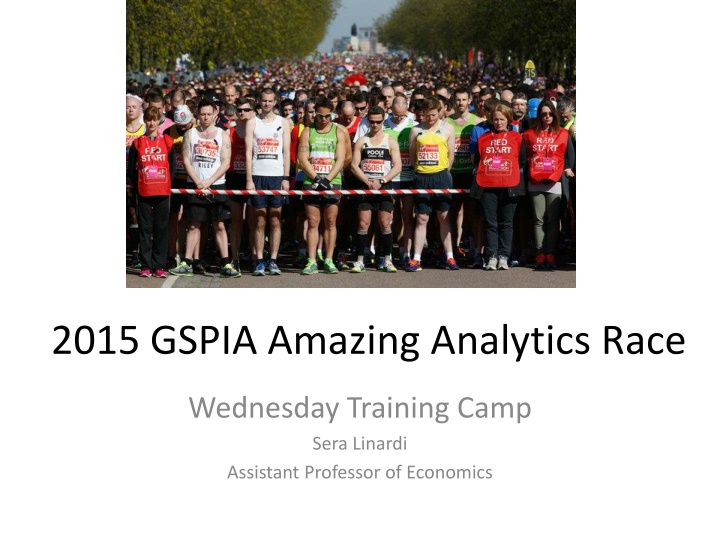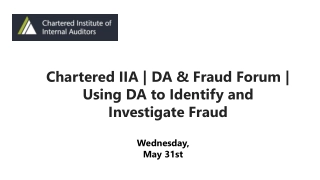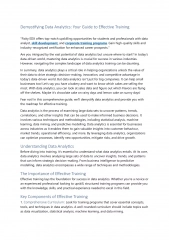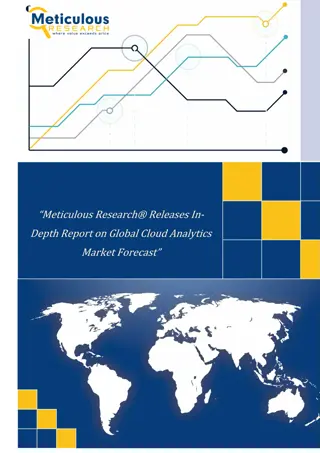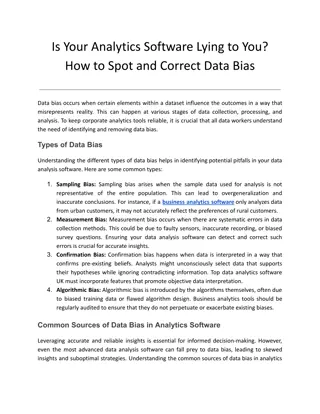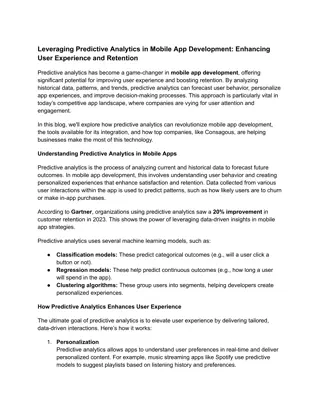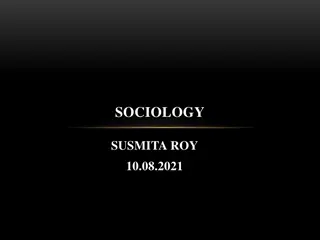2015 GSPIA Amazing Analytics Race
Beginning your GSPIA journey with a focus on practical application of quantitative methods. The workshop aims to connect theoretical concepts to real-world problem solving, offering hands-on experience and insights into policy questions. Participants will meet industry professionals, engage in exercises on STATA and equations, and prepare for the Amazing Analytics Race. The session will not provide guarantees for academic success but will demystify math and highlight research opportunities related to quantitative methods, offering a broad view of the field.
Download Presentation

Please find below an Image/Link to download the presentation.
The content on the website is provided AS IS for your information and personal use only. It may not be sold, licensed, or shared on other websites without obtaining consent from the author.If you encounter any issues during the download, it is possible that the publisher has removed the file from their server.
You are allowed to download the files provided on this website for personal or commercial use, subject to the condition that they are used lawfully. All files are the property of their respective owners.
The content on the website is provided AS IS for your information and personal use only. It may not be sold, licensed, or shared on other websites without obtaining consent from the author.
E N D
Presentation Transcript
2015 GSPIA Amazing Analytics Race Wednesday Training Camp Sera Linardi Assistant Professor of Economics
8:30am Getting ready: Your To-Do List Introductions Gabriel Gerner (IT) and TAs Scott McAllister and Shuning Tong (top 3 finishers in last year s Amazing Race). Introduce yourself to 2 new people around you. 1. 2. 3. 4. Register: find your name, cross it out, get nametags + breakfast Get Stata if you haven t already. Get online if you haven t already. Go to http://www.linardi.gspia.pitt.edu/?page_id=564. The SCHEDULE of the day is online for you to check at any time. Create a folder in your computer for all your files for math camp. Download Sampler, Slides, and the four .csv files into that folder Open STATA, go to File, Change Working directory to your math camp folder. Click on the Baseline math survey and try it. Use the ID # from your name tag. 5. 6. 7. We will start lecture at 9am.
Welcome Your instructor: Sera Linardi (linardi@pitt.edu) PhD in Social Science, 2010, California Institute of Technology Was a computer scientist at Adobe (working on PDF files) I usually teach in the Fall: Micro I, Quant II, Game theory/Behavioral Economics I research motivation to help others and wisdom of the crowds . Sampler contains faculty research / classes that directly or indirectly utilize quantitative methods
What this workshop is and is NOT What are we doing today? We are beginning your GSPIA journey with the end in mind: a career solving real world problems First, let s define what this workshop will NOT do: Guarantee you an A in Quant I or Micro or any quant class Make you a math whiz Explain any mathematical concept in depth What this workshop aim to do: Connect quant methods to the real world. Begin to demystify math for those who fear it. Provide you with a hands-on experience of how quant methods can give you an additional edge in tackling policy questions Give a 1000 feet view of the classes, faculty members, and research opportunities that relates to quantitative methods
Schedule and people you will meet today 9 10:30 Matt von Boecklin, MPIA 13, Monitoring and Evaluation Manager, Liberia 11 Non-linear equation, derivatives (Exercise 2) 12:30 lunch 1:30 Intro to STATA (Exercise 3) 2:45 Michael Lewin, Lecturer (Econ Pub Affairs) & Jeremy Weber, Assistant Professor of Economics (Quant I) 3:30 Teams for Amazing Analytics Race (Group exercise) Linear equations (Exercise 1)
And.. what is GSPIAs Amazing Analytics Race ? At the end of today, you will be randomly split into pairs for tomorrow. Your mission will be explained tomorrow morning at 9am where you will solve a puzzle using real world data, the quantitative methods you learn today, and lots of creativity. You will be given your first clue at 9:15am and you will have 3 hours to accomplish your mission by interlocking a series of 10 clues. What s at stake: 1stplace team = a $200 Bookstore gift certificate. 2nd place team = $100. 3rdplace = $50. After teams are formed today, we will brief you on the rules of the race, and your team will get to practice working together.
How todays training camp works Data - Lecture (<1hr) Exercise (10-15 mins) Review the exercise (5-10 mins) You have the slides in your computer, so you can always go back / make notes, etc. Ask questions! There is no dumb question, this is a refresher workshop so forgetting basic stuff is totally okay. In completing exercise feel free to ask your neighbors/TAs/instructor for help. Please don t browse the internet/ phone for unrelated stuff. If you are waiting for others to finish, see if anyone needs help. Check on your two new neighbors. Try new things in STATA.
Imagine you are an advisor to the mayor of Pittsburgh Peduto, GSPIA 11 He is wondering whether approving 10 new businesses on a strip of a crowded highway: businesses bring job worsens congestion What you have to help you advise him: Data on travel time on several highways given number of cars (Cars.dta) Data on number of cars given number of businesses along the highway (Business.dta) Public opinion expert s estimation that praise = business^2/2, and complaints = traffic wait time.
Breaking down the question into mathematical concepts 1. how long does it take to travel the highway? (random variable) 2. how does the # of cars affect travel time? (correlation, linear regression, slope) 3. can adoption of a different traffic system reduce congestion? (simultaneous equations) 4. how does the # of businesses affect # of cars?(nonlinear equations) 5. what is the optimal # of business to have? (optimization)
1. random variable How long does it take to travel through the highway?
Random variable How long does it take to travel 20 miles on a city highway at 8am in the morning? Hands = 20 mins, 30 mins, 40 mins Different day, same highway, same hour in day = different travel time. Statistics is learning to get the information out of this uncertainty. Time needed to travel is a random variable = the value is subject to variation due to chance. Is what is written on this board ALL possible travel time for the 15 mile highway above? No. That would be the population. This is a sample. We usually only observe a sample of realizations of the random variable of interest. Mean? Note also that if I had asked a different group of people, I would have written different numbers on the board, and therefore get a different mean.
Looking at data Suppose cars.csv contains travel time and # of cars on various Pittsburgh highways How do you load cars.csv into STATA so you can look at it? We ll do it 2 ways today, using the Data Editor and using the insheet command. In general we ll use STATA in two ways today, first using the drop down menu, and then using code. Loading with Data Editor. Open cars.csv in Excel. Highlight, copy. Open data editor. Click on first cell and paste. Treat first row as variable name. Note that the STATA you will learn today is just quick and dirty. You will learn how to use it properly in Quant I (with Jeremy) and Quant II (with me).
Traveltime Mode, median, mean? Histogram Boxplot .05 60 .04 50 .03 Density 40 travelTime .02 30 .01 20 0 10 20 30 40 50 60 10 travelTime hist traveltime graph box traveltime Graphics Histogram ->Variable: traveltime
Showing distribution of data: boxplot The whiskers can mean many things, so we won t focus on it here.
. mean traveltime Mean estimation Number of obs = 1674 Mean Std. Err. [95% Conf. Interval] traveltime 26.71808 .2103392 26.30553 27.13064 Average travel time for that strip of highway is 26.7 minutes. However, the mayor is interested in congestion, so you are also interested in the # of cars on the highway. . mean cars Mean estimation Number of obs = 1674 Mean Std. Err. [95% Conf. Interval] cars 385.3883 5.682063 374.2436 396.533
# of cars on the highway Histogram Boxplot .002 1,500 .0015 1,000 Density .001 cars 500 5.0e-04 0 0 500 1000 1500 0 cars Hmm.. does this help you understand traffic congestion?
2. correlation, linear regression, slope / rate / derivative how does the # of cars affect travel time?
Relationship between two random variables correlation between cars and travel time 60 50 travelTime 40 30 If we can describe this relationship with an equation, we can tell how travel time is affected by cars more generally. 20 10 0 500 1000 1500 cars scatter traveltime cars Graphics Twoway ->Create->Y variable: traveltime, X variable: cars
Scatterplot shows correlation between two variables. To find the relationship, we can try to fit a line across this scatterplot that is the closest possible to ALL the points. This is a regression line.
Regression reg traveltime cars ------------------------------------------------------------------------------ traveltime | Coef. Std. Err. t P>|t| [95% Conf. Interval] -------------+---------------------------------------------------------------- cars | .0311483 .0004892 63.67 0.000 .0301888 .0321078 _cons | 14.7139 .2201573 66.83 0.000 14.28208 15.14571 ----------------------------------------------------------------------------- Statistics Linear model ->Linear Regression ->Dependent variable: traveltime, Independent variable: cars traveltime = 14.7 + 0.03*cars What does it mean?
Interpretation What does it mean? traveltime = 14.7 + 0.03*cars When there s 0 cars, it takes 14.7 minutes to travel? (Intercept) With every additional cars, it takes another 0.03 minutes to travel. (Slope) Or: change in travel time = 0.03 change in # of cars It doesn t matter how many cars are already on the highway. We also say: derivative of travel time with respect to cars=0.03 Or: d traveltime / d cars = 0.03 (Now you know the many ways to refer to this rate of change.)
Drawing a linear function 60 50 40 Linear function: Y=a+bX Travel time = a+b cars With a straight line, an increase in X increases Y by the same amount regardless of what X is currently at. 30 30 20 10 0 500 1000 1500 cars travelTime Fitted values Drawing the graph: traveltime = 14.7 + 0.03*cars Where does the line hit 0? 14.7 This is a (intercept) When cars increase by 1, travel time increase by 0.03 minutes. This is b (slope). When drawing with slopes that are small it helps to use larger increases in x (e.g when cars increase by 1000, travel time increases by 0.03*1000 = 30 minutes)
Looking at a graph and identifying the linear equation Suppose this is a graph of your patience (y) as a function of traffic jams (x). What is the function? Let y=a+bx Step 1: Identify the vertical intercept (0,3) a=3 Step 2: Identify the horizontal intercept (4,0) b = rise/run = 3/-4 Function is y=3-3x/4
Inverting a linear function traveltime = 14.7 + 0.03*cars If it takes you 20 minutes to travel, how many cars are on a freeway?
Inverting a linear function You know travel time as a function of cars traveltime = 14.7 + 0.03*cars You want cars as a function of travel time: Traveltime- 14.7 = 0.03*cars Cars = (Traveltime- 14.7) / 0.03 Cars = Traveltime/0.03- 14.7/0.03 Cars = 33.3*Traveltime - 490 Now, it s easier to answer this question: If it takes you 20 minutes to travel, how many cars are on a freeway? Cars = 33.3*20 - 490 =176 (BTW: what is the intercept and slope of this inverted function? Intercept = -490 Slope 33.3 What is dCars / dTraveltime ? 33.3 )
Digression: when will you have to invert linear functions? Quite often actually. For example in economics. Here is a demand function Qd = 100 - 2P It is natural to draw this with Qd in the Y axis and P in the X axis (with 100 as the intercept and a -2 slope). But the convention is to draw it with P in the Y axis price as a function of quantity. So you have to invert it. Here is the inverted demand function 2P = 100 - Qd P = 50-Qd/2 Now you can draw the demand function.
How many additional businesses should be allowed along a busy highway to maximize citizens satisfaction? Breaking down the question into mathematical concepts how long does it take to travel the highway? (random variable) On average 26.7 minutes. how does the # of cars affect travel time? (correlation, linear regression, slope) Travel time = 14.7+0.03 cars can adoption of a different traffic system reduce congestion? (simultaneous equations) how does the # of businesses affect # of cars?(nonlinear equations) what is the optimal # of business to have? (optimization, derivatives, chain rule) 1. 2. 3. 4. 5.
3. comparing two highways: should you adopt another traffic system? (simultaneous equations, or, systems of equations)
Previously you learned that for Pittsburgh highways, traveltime = 14.7 + 0.03*cars. A colleague suggested that in anticipation of congestion from the new businesses, you should consider a traffic system that has been adopted by Cleveland to reduce travelling time. There, traveltime = 8.7 + 0.05 cars. Should you do that? What is the maximum # of cars such that travelling with the Cleveland system is faster than the Pittsburgh system?
Pittsburgh: Traveltime = 14.7 + 0.03 cars Cleveland : Traveltime = 8.7 + 0.05 cars The question asks for what is cars such that traveltime is equal to each other. Travel time cars Several methods: You can solve a linear systems by: 1. Graphing: draw both lines and see where they meet. 2. Substitution: Traveltime = 8.7 + 0.05 cars 14.7 + 0.03 cars = 8.7 + 0.05 cars 6 = 0.02 cars. Cars = 300 Given that mean # of cars on Pittsburgh highways is 385 (see data), the Cleveland system would actually cause more congestion.
(A) 2x 3y= 2 x + 2y= 8 Nature of Solutions to Systems of Equations y 5 (4, 2) y (B) 4x + 6y= 12 2x + 3y= 6 5 x 5 5 x 5 5 5 Lines intersect at one point only. Exactly one solution: x = 4, y = 2 5 y Lines are parallel 5 No solution. (C) 2x 3y = 6 x 5 5 x + 3/2y = 3 5 Lines coincide. Infinitely many solutions. 8-1-85
Other applications: making inferences An NGO is running a refugee camp. Cost per day is on average $1.50 for children and $4.00 for adults. On a certain day, 2200 people were living in the camp and $5050 was spent that day. How many children and how many adults are in the camp? number of adults: a number of children: c total number: a + c = 2200 total cost: 4a + 1.5c = 5050 a = 2200 c 4(2200 c) + 1.5c = 5050 8800 4c + 1.5c = 5050 8800 2.5c = 5050 2.5c = 3750 c = 1500 a = 2200 (1500) = 700 There were 1500 children and 700 adults.
You will also see a lot of simultaneous equations in economics, so let s preview them. Earlier in linear functions Price E.g Qd = 160-8P To draw, invert it: 8P = 160-Qd P = 20 Qd/8 20 demand Vertical intercept = 20 To draw the horizontal intercept, set P to 0 and solve for Qd. 0=20-Qd/8 Qd=20*8=160 Note this is the same as the vertical intercept in the non-inverted function (160) P* quantity Q* 160
Now: Two linear functions: for example: Supply-demand equilibrium in perfect competition supply Qd = 160-8P Qs = 70+7P P* 160-8P=70+7P 90 = 15P P=6 The intersection of the supply and demand curve (P*, Q*) represents the equilibrium. Equilibrium price: price where there is the same number of people who wants to buy as there are people who wants to sell demand Q* quantity
Alumni chat: Matt von Boecklin MPIA 13 More than Me Foundation, Liberia Monitoring and Evaluation Manager May 2015 - Present Project: Get REAL (Rebuild Education for All Liberians), a developing joint effort with the Ministry of Education to improve primary schools throughout Liberia. National Entrepreneurship Network (NEN), Bangalore, India Entrepreneur Support and Impact Assessment Fellow May 2014 2015 Project: Dream to Destination Entrepreneur Support Program, a year-long intervention focusing on improving fundability, scalability, and revenue growth for 100 women-owned Indian enterprises. Vital Voices Global Partnership, Washington D.C. Program Evaluation Consultant February - May 2014 Data Analysis Coordinator June 2013 - January 2014 Project: Vital Voices Global Leadership Awards Program, an annual, weeklong event meant to enhance the credibility and visibility of extraordinary women leaders from around the world.
15 minutes break When we return (11am) : Review Exercise 1 Linear functions
Review Exercise 1 Questions?
How many additional businesses should be allowed along a busy highway to maximize citizens satisfaction? Breaking down the question into mathematical concepts how long does it take to travel the highway? (random variable) On average 26.7 minutes. how does the # of cars affect travel time? (correlation, linear regression, slope) Travel time = 14.7+0.03 cars can adoption of a different traffic system reduce congestion? (simultaneous equations) how does the # of businesses affect # of cars?(nonlinear equations) what is the optimal # of business to have? (optimization, derivatives) 1. 2. 3. No. 4. 5.
4. Nonlinear function what would new businesses do to highway congestion? We will now use our other data set, business.csv This data set has # of businesses on a highway and the number of commuter cars associated with these businesses.
clear Load new Business.csv Look in data editor (you must clear out the old data) What relationship are we trying to figure out?
scatter commutecars business 2000 1500 commutecars 1000 500 Is this a linear function? Will a straight line give you the smallest error? 0 0 20 40 60 80 100 business
Nonlinear functions Let s find what our function resembles: Quadratic function Logarithmic function Exponential function
Quadratic function Y=x2 x Y -3 9 -2 4 -1 1 0 0 1 1 2 4 3 9 Notice how Y changes as X change. The slope is no longer the same ( not a constant ) The change in Y is 1 as x goes from 0 to 1, 3 as x goes from 1 to 2, 5 as x goes from 2 to 3.
Other quadratic functions y = ax2+ bx + c y = (ax + b)(cx + d) y = a(x+b)2+ c Is a>0 or a<0 here? Quadratic functions are one type of polynomial functions:
Working with polynomials more generally Example: Y=3x8 Identify: m constant, x variable, c exponent Q=.4P1/3 Generally: Y=mxc Some special ones: x1 = x x-1 = 1/x x0 = 1 x1/2 = sqrt(x) When there is no constant, the hidden constant is 1. E.g, when you see = x, think 1*x1 When there is no variable, the hidden variable has a power of 0. E.g, when you see = z, think z*x0 x-2 = 1/x2
Derivatives: the slope of a polynomial the power rule: if y=mxc , dy/dx= mcxc-1 y=3x2. constant=3, var =x, exponent=2. dy/dx=3*2x(2-1) =6x y=x-1. constant=1, var=x, exponent=-1. dy/dx=1*-1x(-1-1) = -1x-2 = -1/x2 If you see things like this: y = ax5+ bx3 + cx it s just the same =mxc you can deal with the terms one at a time. But you may need to simplify the equation first. When will you use this in class? When you re trying to figure out rate of change.
Quadratic function Y=X2 dY/dX = 2X1=2X x Y -3 9 -2 4 -1 1 0 0 1 1 2 4 3 9 Earlier: the actual change in Y is 1 as X goes from 0 to 1, 3 as X goes from 1 to 2. With the derivative the approximated change in Y is 0 as X goes from 0 to 1 (X=0, dx=1), 2 as X goes from 1 to 2, 4 as X goes from 2 to 3. How would Y change if X goes from 5 to 5.2? This is asking for dY if X=5, dX=0.2 dY = 2X*dX =2*5*0.2 =2 To check, do 5.22 52 = 2.04 pretty close
Rules for simplifying polynomials xn xm= xn+m 23 24= 23+4= 128 Product rules xn bn= (x b)n 32 42= (3 4)2= 144 xn/ xm= xn-m 25/ 23= 25-3= 4 Quotient rules xn/ bn= (x / b)n 43/ 23= (4/2)3= 8 (xn)m= xn m (23)2= 23 2= 64 Power rules When will you use this in class? When you re working with utility functions.
Exponential function The growth of a terrorist cell: At month 0 there s 1 person At month 1 this person recruited 2 people At month 2 each persons recruited 2 people What is the function that describe the growth? f=2x where x is time (month) 1 2 4 This is an exponential functions Notice it asymptotes at the y axis.
